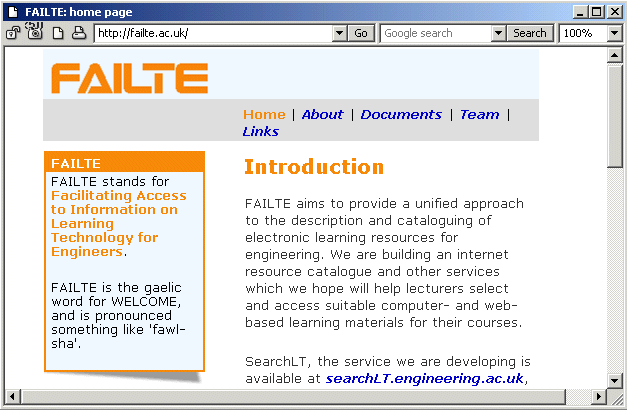The FAILTE project [1] was funded by JISC to provide a service which engineering lecturers in higher education could use to identify and locate electronic learning resources for use in their teaching. The project started in August 2000. One of the first tasks was to set up a project Web site describing the aims, progress and findings of the project and the people involved.

Figure 1: The FAILTE home page
As an experienced Web author I decided to use this opportunity to experiment with two specifications which at that time were relatively new, namely cascading style sheets (CSS) and HTML. At the same time I also wanted to create pages which looked reasonably attractive on the Web browsers in common use (including Netscape 4.7 which has poor support for CSS) and which would at least display intelligible text no matter what browser was used.
Here is not the place for a detailed discussion of the merits of separating logical content markup from formatting, but I will say that I think that, since this is how HTML was envisaged by its creators, it works best when used in this way. Some of the reasons at the time of starting the Web site were:
A quick investigation of the Web server log files from a related server which dealt with the same user community as our project targeted lead us to the decision that we should worry about how the Web site looked on Netscape 4.7, but not browsers with poorer support of XHTML and CSS (e.g. Netscape 4.5 and Internet Explorer 3).
The Web site was a small one, and there would be one contributor: me. This meant that I did not have to worry about the lack of authoring tools for XHTML at the time of setting up the Web site. I used HomeSite version 4.5, a text editor for raw HTML code, mainly because I was familiar with it. Divisions (<div> tags) were used in place of tables to create areas on the page (a banner at the top, a side bar for providing a summary of the page content), graphics were used sparingly, and colour was used to create a consistent and recognisable look across the site. It is also worth noting that I approached the design of the Web site with the attitude that it I could not assume that it would be possible to control layout down to the nearest point.
While writing the pages I tested mainly against Netscape 4.7, since this had the poorest support for XHTML and CSS . I also made heavy use of the W3C XHMTL and CSS validation service [2], and against Bobby [3] to check for accessibility issues. Once the code validated and achieved the desired effect in Netscape 4.7 I checked the pages against a variety of browser platforms.
While it was never my aim to comply with a particular level of accessibility, the feedback from Bobby allowed me to enhance accessibility while building the pages.
Most of the problems stemmed from the need to support Netscape 4.7, which only partially implements the CSS specification. This cost time while I tried approaches which didn't work and then looked for work-around solutions to achieve the desired effect. For example, Netscape 4.7 would render pages with text from adjacent columns overlapping unless the divisions which defined the columns had borders. Thus the <div> tags have styles which specify borders with border-style: none; which creates a border but doesn't display it.
The key problem here is the partial support which this version of Netscape has for CSS: older versions have no support, and so the style sheet has no effect on the layout, and it is relatively easy to ensure that the HTML without the style sheet makes sense.
Another problem was limiting the amount of white space around headings. On one page in particular there were lots of headings and only short paragraphs of text. Using the HTML <h1>, <h2>, <h3>, etc. tags left a lot of gaps and led to a page which was difficult to interpret. What I wanted to do was to have a vertical space above the headings but not below. I found no satisfactory way of achieving this using the standard heading tags which worked in Netscape 4.7 and didn't cause problems in other browsers. In the end, I created class styles which could be applied to a <span> to give the effect I wanted e.g.:
<p><span class="h2">Subheading</span><br />
Short paragraph</p>
This was not entirely satisfactory since any indication that the text was a heading is lost if the browser does not support CSS.
The Web site is now two years old and in that time I have started using two new browsers. I now use Mozilla as my main browser and was pleasantly surprised that the site looks better on that than on the browsers which I used while designing it. The second browser is an off-line Web page viewer which can be used to view pages on a PDA, and which makes a reasonable job rendering the FAILTE Web site - a direct result of the accessibility of the pages, notably the decision not to use a table to control the layout of the page. This is the first time that the exhortation to write Web sites which are device-independent has been anything other than a theoretical possibility for me (remember WebTV?)
I think that it is now much easier to use XHTML and CSS since the support offered by authoring tools is now better. I would also reconsider whether Netscape 4.7 was still a major browser: my feeling is that while it still needs supporting in the sense that pages should be readable using it, I do not think that it is necessary to go to the effort of making pages look attractive. In particular I would not create styles which imitated <Hn> in order to modify the appearance of headings. I look forward to the time when it is possible to write a page using standard HTML repertoire of tags without any styling so that it makes sense as formatted text, with clear headings, bullet lists etc., and then to use a style sheet to achieve the graphical effect which was desired.
 Phil Barker
Phil Barker
ICBL
MACS
Heriot-Watt University
Edinburgh
Email: philb@icbl.hw.ac.uk
URL: http://www.icbl.hw.ac.uk/~philb/
Citation Details:
"Standards and Accessibility Compliance for the FAILTE Project Web Site",
by Phil Barker, Heriot-Watt University.
Published by QA Focus, the JISC-funded
advisory service, on 4th November 2002.
Available at http://www.ukoln.ac.uk/qa-focus/documents/case-studies/case-study-02/
QA Focus Comments
The FAILTE project was funded by the JISC's 5/99 programme.
In a number of surveys of JISC 5/99 project Web sites carried out in October / November 2002 the FAILTE Web site was found to (a) comply with XHTML standards, (b) comply with CSS standards and (c) comply with WAI AA accessibility guidelines.
Brian Kelly, QA Focus, 4 November 2002
Citation Details
Standards and Accessibility Compliance for the FAILTE Project Web Site, Barker, P., QA Focus case study 02, UKOLN,
<http://www.ukoln.ac.uk/qa-focus/documents/case-studies/case-study-02/>
First published November 2002.
Changes